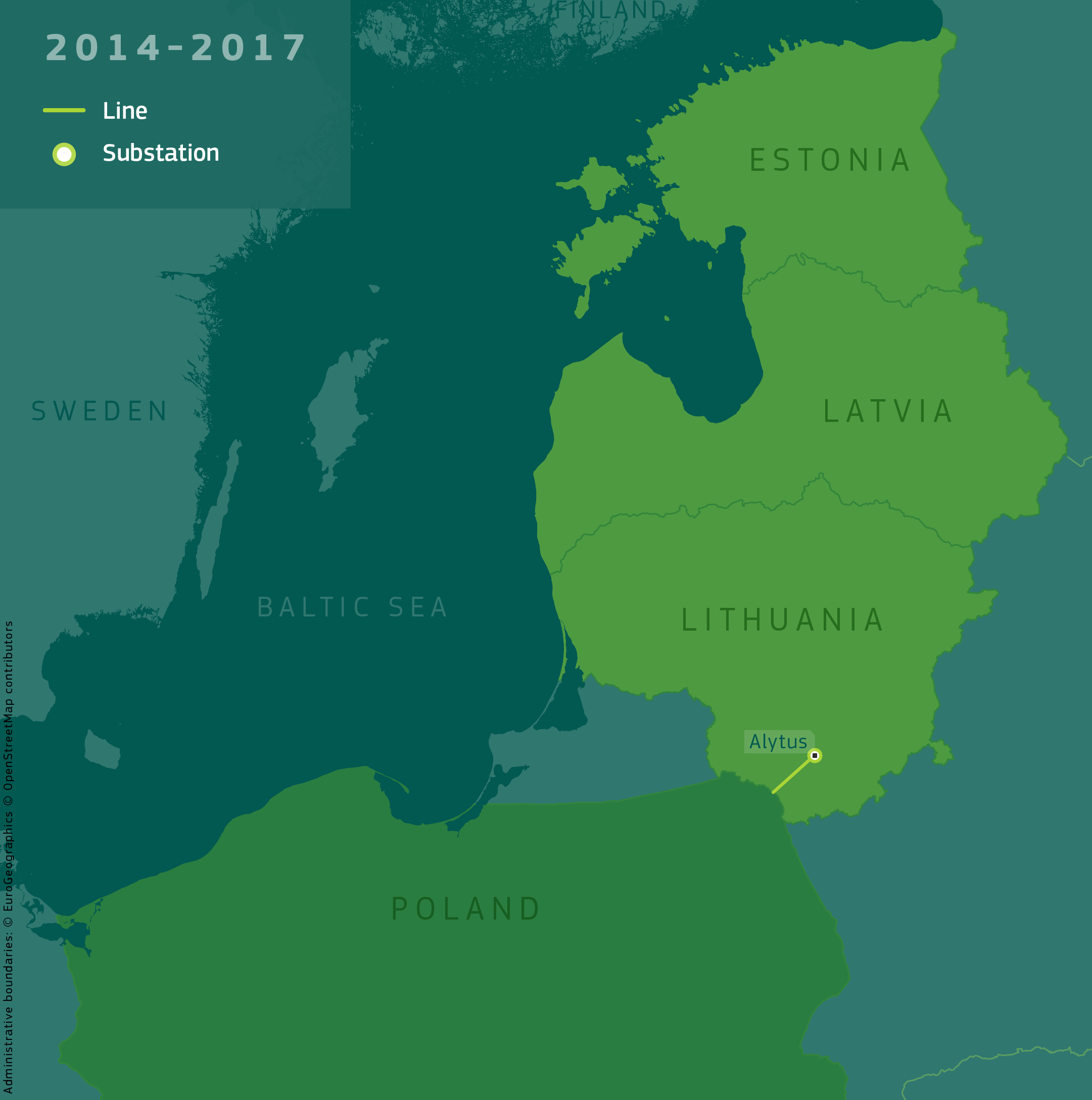The maps below illustrate the infrastructure and IT equipment funded by CEF Energy over time. Each map represents a 3-4-year phase and, by comparing the starting point with the current status, it becomes clear that EU funding has been instrumental in constructing and upgrading the network and, ultimately, enabling this important milestone for the entire EU energy network.
Click on the maps to enlarge them and navigate through the phases; then scroll down on this page for further details.
Phase 1: 2014-2017

Phase 1 marks the beginning of a new era of energy cooperation and market integration in the Baltic States. It is characterised by the completion of two studies helping to identify the technical and financial requirements for a successful Baltic synchronisation with the CEN. It also includes the completion of pivotal infrastructure, namely LitPol Link, which connects the Lithuanian electricity system from Alytus substation 400 kV switchyard to the Polish electricity system at the Lithuanian/Polish border. This project not only enhances the security of supply in the Baltic Region but its importance extends beyond the two participating countries, as it contributes to the EU's broader energy policy goals promoting a more resilient and sustainable energy system.
Phase 2: 2018-2021

Phase 2 has seen the completion of a study on the dynamic behaviour of synchronously interconnected Baltic States with CEN, as well as the completion of several key cross border connections and internal lines in Estonia and Latvia. Collectively, these contribute to the development of the building blocks necessary for achieving synchronisation and ensuring connectivity in a harmonised energy market.
The internal line between the Riga CHP2 (Combined Heat and Power Plant 2) with the Riga HPP (Hydro Power Plant) in Latvia enables the efficient transfer of electricity between these two major power generation and consumption centres in the region. It also provides grid stability and increased transmission capacity. Its completion provides the full functionality for the third electricity interconnection between Estonia and Latvia in the emergency and maintenance modes. Also known as the Interconnection between Kilingi-Nõmme (EE) and Riga CHP2 substation (LV), this significant project enhances the energy security and stability between the two countries and improves their integration possibilities for renewable sources. The internal lines in Latvia between Ventspils, Tume and Imanta, also known as the Kurzeme Ring project, have contributed towards enhancing the country's power grid resilience, reliability, and efficiency.
Phase 3: 2022-2025

Phase 3 is characterised by an increase in activity, focusing on technical integration, collaboration, and project implementation. As the works continue to progress, this phase has witnessed an unprecedented level of engagement, with various stakeholders contributing to maintaining the project's momentum. Phase 3 has seen the completion of two studies contributing to the preparatory phases for the works and a series of internal lines, grid infrastructure upgrades, synchronous condensers, substations, a battery and several IT developments.
This phase will see the commissioning of 6 Synchronous condensers (2 in each Baltic State), playing a critical role in voltage control, frequency regulation, inertia provision and grid stability. They are considered the most important equipment needed for the Baltic countries to prepare for independent power frequency management. Their construction brings us a step closer to achieving the twin goals of energy independence and system reliability.
12 lines will be fully commissioned by the end of this phase, spanning the 3 Baltic States and Poland. They contribute towards providing further connectivity and strengthening the security and reliability of the grid. Furthermore, the construction of a substation and switchyard in Lithuania, shunt reactor circuit breakers in Estonia and a Battery Energy Storage Systems (BESS) in Latvia all contribute towards being connected and creating an efficient energy market in the region. Lastly, in preparation for synchronisation, deploying and upgrading new information systems and solutions is also carried out to facilitate a seamless connection to the common European electricity balancing market platforms. This includes a series of IT investments across the Baltic States.
Phase 4: 2026 and beyond

The synchronisation of the Baltic States with the CEN is a significant milestone, however, the journey does not end there. Beyond the official synchronisation date of February 2025 work will continue.
Internal lines in Poland are to be completed as is Harmony Link the transmission link between Poland and Lithuania, which will enable the exchange of electricity between the two countries and further enhance the integration of the Baltic States in CEN.
In Lithuania, work will also continue on the upgrades of the control system of NordBalt HVDC interconnector between Lithuania and Sweden - improving the reliability of the energy supply, reduced dependence on imported fuels, and promoting the use of renewable energy sources.
In Estonia, IT investments and upgrades are ongoing as is work related to EstLink 1 and 2 linking Estonia to Finland.





















